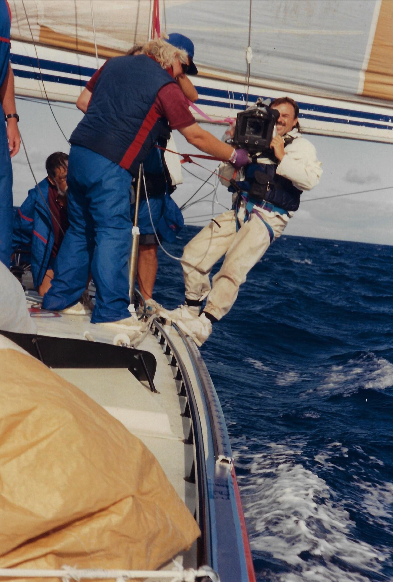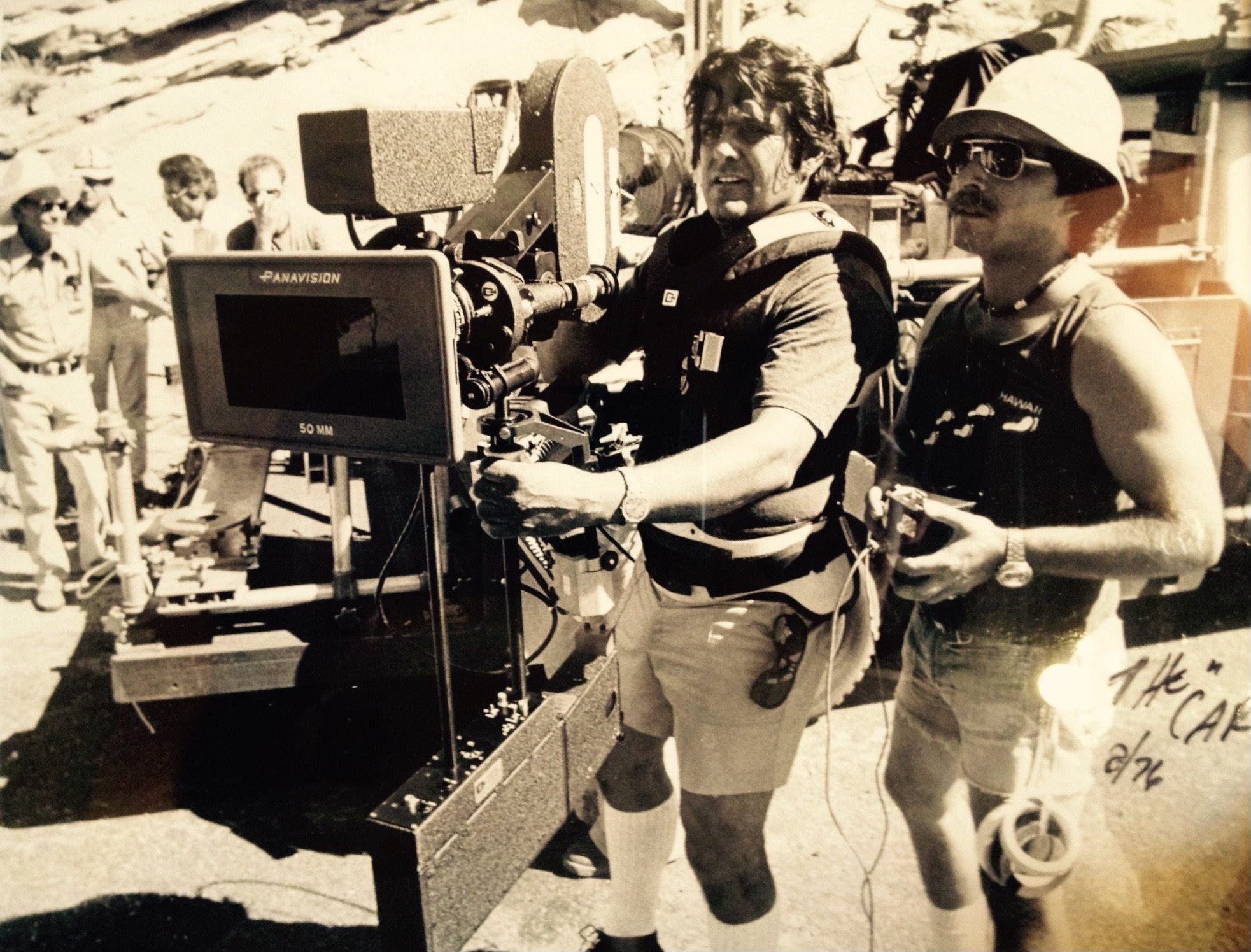The Way It Was
How things were done back in the day. If you have old pictures you’d like to add, please send them to us with info on anyone in the picture and who took it if possible. We have a board of people who decides what goes up and will run it by them. If you see a picture here and know some info that is not listed or find a mistake, please let us know.
****Please note, we will not share new pics taken on set because set photographers are the only people who should be taking pictures in that environment.****
The Blues Brothers, 1980. Camera Op Steve Yaconelli checks in with John Belushi in between takes. One hopes this was not a moving shot, but alas, it was a different time.
1941, 1979. Cinematographer Bill Fraker rides the crane as the great Toshiru Mifune looks on.
The Searchers, 1956. Photograph by Alexander Kahle
The Godfather Part II, 1974. Photo by Bruce McBroom.
Oblivion, 2013. Photo by David James.
Star Wars, 1977.
Gone With The Wind, 1939. Photo by Fred Parrish
White Corridors, 1951. Director Pat Jackson, camera operator Ernest Steward, cinematographer C.M. Pennington-Richards, James Donald and Googie Withers line up a shot.
Dr. Zhivago, 1965. Photo by Kenneth Danvers.
The Ladies Man, 1961. Director Jerry Lewis rides the crane for a birds eye view.
The Shining, 1980.
Office Space, 1999. Operator Charles Papert yucks it up with the gang.
"The ultimate in field-level coverage is the camera mounted on a jeep. This too has been talked about for many years, but in the 1950 season KTTV in Hollywood actually put the idea into practice. The jeep was converted into a 'camera car' by bolting on a channel steel support which extended a foot or so out from the back, on which could be mounted the rotating turret of a studio Sanner camera crane. Although this camera was not used for trucking shots, it could easily keep abreast of the line of scrimmage and a very dramatic low shot down the line was obtained which could be used just before the start of each play." – Techniques of Television Production, by Rudy Bretz (McGraw-Hill, 1953)
It Always Rains On Sunday, 1947. Googie Withers and Edward Chapman perform in front of the camera. Jeff Seaholme operates while AC Peter Newbrook pulls focus. Photograph by Eddie Orton
Rear Window, 1954. Alfred Hitchcock working with veteran camera operator William Schurr.
High Anxiety (1977). Ed Koons operates while Mel Brooks steals the scene. Photograph by Elliott Marks
The Graduate, 1967
MacGyver, 1987. Operator Casey Hotchkiss on his first job as a camera operator.
Moving and Talking Picture Company, 1969. Camera Op Phil Parmet lines ups. shot for Director Garrett Brown on a commercial for Mr. Browns company. The steadicam was not even a dream yet.
Legendary Operator Dick Colean (rare photo showing him with shoes as he was known for always wearing flip flops).
A Summer Place, 1959. Harry Stradling Sr. sits behind the camera while his son, Harry Stradling Jr.. looks on. Photo Courtesy of Roy Wagner Archives.
The Day The Clown Cried, 1972.
Heat, 1995. The incredible Jimmy Muro running with his lightweight steadicam running rig alongside Al Pacino. The motion apparent in this picture lets you know how hard this shot was to pull off.
Leon The Professional, 1994
The Rose, 1979. Bette Midler relaxes in between takes leaning against operator Nick McLean Sr. If there is a picture that better embodies the film industry in the 70s....
ET, 1982. Steven Spielberg lines up the shot of ET's POV while trick or treating.
The Great Hospital Mystery, 1934. William Demarest, Sig Ruman, Joan Davis, Thomas Beck and Sally Blane on the set. Director James Tinling is seated at the foot of the bed and cinematographer Harry Jackson is the gentleman with the hat next to the camera.
Do The Right Thing, 1989. Photo by David Lee
Poison, 2023. Director Wes Anderson tries out the ZeeGee rig being worn by his long time Key Grip/DollyGrip/Steadicam Op, Sanjay Sami.
Bullitt, 1968. Courtesy Roy Wagner, ASC
The Last Temptation of Christ, 1988. Photograph by Mario Tursi.
Taxi Driver, 1976. Shooting the finale of the movie from overhead required cutting open the floor of the apartment above to accommodate for the camera.
Singing in the Rain, 1952. The moment before the camera sweeps up and away at the end of the number "Broadway Melody". Camera Operator Frank Phillips is kneeling behind the camera and that's his handwriting at the bottom of the photo. Camera is a three strip Technicolor built by Mitchell without the sound blimp. Photo Ed Hubbell. Courtesy of Roy Wagner, ASC.
The Stuntman, 1980. Steadicam operator Joel King and Mario Tosi on the set.
The Deer Hunter, 1978. Cinematographer Vilmos Zsigmond prepares a shot of John Savage.
Unknown, but a beautiful representation of what we all do.
The Princess Bride, 1987. Clapper/Loader Terence Nightingall gets ready to hit the sticks.
Wind, 1992. John Toll ASC doing whatever it takes to get the shot.
Submitted by Andy Romanoff with the following description. "I don't know what show, I don't remember who this is, but what a perfect encapsulation of why we thought being behind the camera was the best job in the world..". We couldn't agree more.
The Entity, 1982. The first time the Louma Crane was mounted on a Super Nova. Operator was Joe R. Marquette Jr and the dolly grip was Bobby Gaynor "who swung the rig like it was a feather".
The Car, 1977. Hector Figeuroa on the front of International Cinematographer.
Star Wars, 1977 Boom Op Ken Nightingall unknowingly creates a phenomenon that will take 45 years to be realized.
The 39 Steps, 1935
A Taste of Blood, 1967. DP Andy Romanoff films bad guy Bill Rogers and his victim with a handheld Arri 2c
Macarthur, 1977. Early Steadicam on set operated by Joel King.
2001 A Space Odyssey, 1968. Stanley Kubrick contemplates a shot behind the rackover BNC.
ER, 1995. Article about Steadicam Op Guy Norman Bee
Rocky 1976. Garrett Brown, Sylvester Stallone, a bunch of kids, and some iconic steps.
Beautiful Boy, 2017. Randy Johnson boom op doing what he does best, wherever he needs to be.
The Car, 1977. Hector Figeuroa holding the steadicam and Tony Rivetti pulling focus. This was the original steadicam build where the motor for the camera was in the base and a spindle up the post ran the camera. The camera, a modified 2c, was attached to the rig permanently. From 1st AC Tony Rivetti - "1976, THE CAR, Leitz remote cable focus. The Arri 2C was modified to full frame for Panavision 2.40 Anamorphic lens. Hector put it on day 1 and carried it for the next 50 straight days of shooting!"
The Bullet Car as used on Sugarland Express. Steven Spielberg in the passenger seat, AC Ed Nielsen adjusting a camera up front and possibly Vilmos Zsigmond cinematographer on the camera.
The Spanish Dancer, 1923. Herbert Brenan directs Antonio Moreno while James Wong Howe lines up the shot.
Clint Eastwood shooting with an Arri 2c on the set of Coogans Bluff, 1968. Guiding him is legendary 1st AC Richard Barth. Eastwood has always given credit to Director Don Siegel for mentoring him and this picture appears to suggest that was hands on training. Coogan’s Bluff (1968) was their first film together. They made four more: Two Mules For Sister Sara (1970), The Beguiled (1971), Dirty Harry (1971) and Escape From Alcatraz (1979).
Jerry Lewis on set circa 1966 with an early version of what was called "Jerry's Noisy Toy". Lewis is credited with helping develop the first video assist systems for film production after seeing the cameras that Jackie Gleason used on the Honeymooners.
Romance on the High Seas, 1948. Cinematographer Elwood Bredell (wearing visor), director Michael Curtiz, Eric Blore and Doris Day
Camera operator Michael Chapman (standing) looks down into the sharks mouth while setting a shot on the set of Jaws, 1975
Titanic, 1997. Steadicam Op Guy Bee and Director James Cameron in between sinking.
Bound For Glory, 1975. Garrett Brown does the first feature steadicam shot in history and changes the way we make movies.
Wayne's World, 1992. Steadicam Op Guy Bee and Mike Meyers clowning for the camera.
1972. ""On remotes or in the studio, CFTO's hand-held TK-44 cameras provide an extra measure of flexibility."" Two steps forward, one step back.
Another Stakeout, 1993. Steadicam Op Guy Bee filming a small flame gag.
The Shining, 1979. Stanley Kubrick and Garrett Brown putting steadicam on the map.
Blood Feast, 1963. Andy Romanoff rides an improvised crane that might not be OSHA approved.
That Certain Age, 1938.
Wolfen, 1981. DP Gerry Fisher at the Louma console, might be Tom Priestly and Stuart Allen just starting his long Louma/Techno career on the right.
Commando, 1985. Joe Valentine operating Steadicam. Photo by Bruce McBroom
Con Air, 1997. Utah Salt Flats. LtoR Boom Op Randy Johnson, Sound Mixer Art Rochester and 2nd Boom Op Mark Grech.
Goodfellas, 1990
Streetcar Named Desire, 1950. Ok, it doesn't have to do with operating but come on, this is cool.
The Man From The Diners Club, 1963. Danny Kaye, cinematographer Hal Mohr and Director Frank Tashlin (kneeling) discuss the next shot.
ER, 1996 Steadicam Op Guy Bee getting a note from Director/Producer Chris Chulack
1981, NYC. Andy Romanoff tests an offroad version of the Louma Crane to see if it would work. It did.
Almost Famous, 2000. The perfect cast photo from a perfect film.
Looking To Get Out, 1982. Director Hal Ashby and Cinematographer Haskel Wexler ASC with crew.
Rear Window, 1954
Superbowl XV, 1981. Louma crane becomes the first remote crane to be used on live sports.
1968. Tom Markle, Gaffer with a finger on the iris, and DP Andy Romanoff shooting a documentary for PBL, the predecessor of PBS.
2001 A Space Odyssey, 1968
The Godfather, 1972 Photo by Bruce McBroom
Unknown, but pretty darn cool.
Seminole, 1953. Note the size of the three strip Technicolor camera.
Jan Harlan's 1976 note to Stanley Kubrick introducing him to the Steadicam
Bound For Glory, 1975. Garrett Brown debuts the steadicam. Not the small size of the steadicam arm and where it originally connected to the vest.
Elizabeth, 1998. Photograph by Alex Bailey
The Magnificent Ambersons, 1942. Orson Welles lines up a shot. Photograph by Alexander Kahle
Lawrence of Arabia, 1962.
The Shining, 1980.
Ferrari, 2023. Photo by Eros Hoagland
Indiana Jones and the Temple of Doom, 1984.
Roar, 1981. Considered to be the most dangerous movie ever made.
Unknown but certainly funky.
The Shining, 1980. Note what looks like dolly track on the stairs!
Director Charlie Chaplin lines up a shot.
The Godfather, 1972. Photo by Bruce McBroom.
Star Wars, 1977. Photograph by John Jay
All In The Family, 1971. Tech rehearsal.
Baby Driver, 2017.
D'Artagnan, 1968. Principal cameraman François About operating a Mitchell S35R 35mm reflex camera, and writer/director Claude Barma, walkie-talkie in hand, in a Citroën 2 CV camera car, during an outdoor shoot of the French ORTF2 television miniseries "D'Artagnan" a Franco-Italian-German co-production. The action scene was shot near the Château de la Roche-Courbon in France 1968.
West Side Story, 2021. Rockstar Steadicam operator John "Buzz" Moyer making it looks easy.








































































































